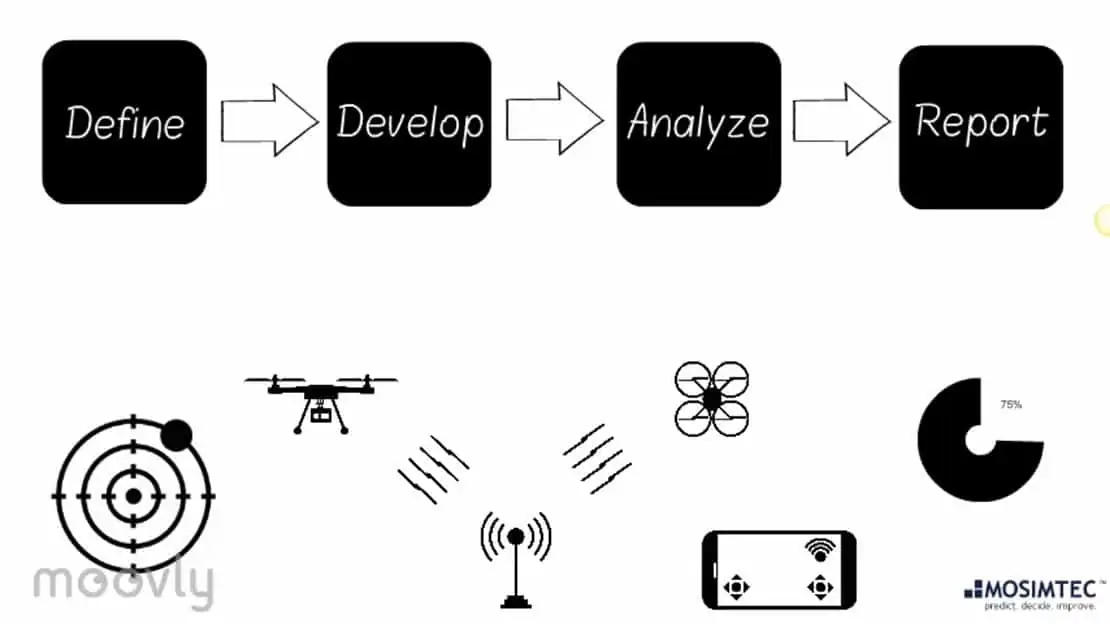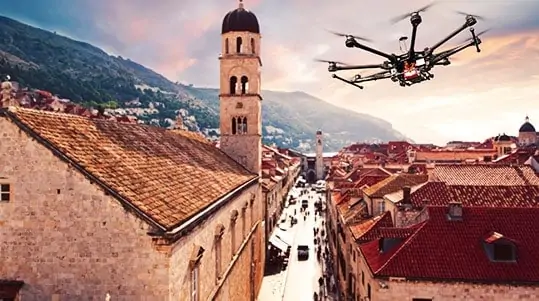Where simulation modeling of UAV systems can help?
Help determine what assets to invest in and how best to use them
Simulate your business process using different drone systems before making capital commitments
Simulate you information volume handling capability for your overall system
Determine the optimal load capacity and flight times for various jobs
Assess impact of maintenance and unscheduled downtimes on your system productivity
Test communication protocols at both operational and business levels of the system
Operate system in a virtual environment to test constraints and identify bottlenecks
How reliable is your system to handle unexpected failures and disruptions
Use 3D simulation models to communicate the typical use of UAVs to stakeholders, both inside and outside, your organization
Study impact of various regulatory restrictions on your system
Conduct disaster recovery planning and exercises in a virtual environment
What can a drone system simulation analyze?
A drone system comprises of different kinds and quantities of Unmanned Aerial Vehicles (UAV), human operators, ground control stations, communication network, IT systems and other components. Due to the complex nature involving multiple variables, a simulation model of the drone system helps to better design and operate a UAV fleet.
How drones can benefit your industry
Commercial drones will change the way we do our jobs, improve our decision-making and save lives.
Jonathan Downey
How drones can help
Surveying and mapping lands to identify problems or manage growth; Reduce labor costs and boost production; Monitor cattle and other livestock.
Economic benefits
Agricultural drones will generate an estimated $350 million in revenue in the next 10 years.
Environmental benefits
Drones can map a landscape in an effort to reduce wildfires and protect wildlife.
How drones can help
Survey stockpiles with impressive accuracy at a fraction of the cost; Create 3-D maps of mines, allowing for more accurate production estimates; Dramatically increase productivity while mitigating safety hazards; Mineral exploration.
Economic benefits
Renting a helicopter for site inspection can cost as much a $2,000 per hour whereas hiring a drone operator costs as little as $200 per hour.
Environmental benefits
Drones can assess and measure environmental impacts on the land.
How drones can help
Oil pipeline inspections; Oil spills and damage detection; Gas emission monitoring; Flare stack inspections.
Economic benefits
Drones can inspect the flare stacks while still in production, avoiding a plant shutdown and saving more than $4 million; Using drones for mapping of pipeline routes can identify animal dens in advance, whereas in the past, coming within 5 miles of a polar bear den, for instance, would have meant replanning of routes at a cost of millions of dollars to avoid the animals.
Environmental benefits
The oil spill detection technology allows swift emergency response in order to minimize damage to the surrounding environment.
How drones can help
More frequent track inspections at a fraction of the cost; Help reduce derailments and other safety problems.
Economic benefits
Lower labor costs in the long run: the average salary of a private rail inspector is more than $71,000 per year so equipping those inspectors with drones could allow the same work to be done by far fewer people.
Environmental benefits
The amount of oil imported into California alone jumped over 500% to 6.3 million barrels in the last 2 years. The volume of oil being transported by rail has swelled, leading to an increase in derailments and oil spills. The use of drone technology to monitor rail tracks will significantly reduce the number of derailments and reduce the risk to the environment in proximity to the track.
How drones can help
Use smart drone for transportation. Send things through the air — magically, with the touch of a button. UAVs have the potential to revolutionize last-mile logistics, transforming the way you access things locally.
Economic benefits
More than two thirds of the goods we access everyday weigh less than 1 kilogram. Medicine, documents, electronic goods — our need to transport lightweight goods on-demand, efficiently and cost-effectively is growing every day.
Environmental benefits
A network of Unmanned Aerial Vehicles operating 24/7/365 is able to meet this demand at minimal cost and the smallest carbon footprint of any transportation system ever invented.
Drone system simulation improves decision making in these areas
Using a simulation model to decide on the cost of using humans vs. UAVs to address a business problem.
Identifying locations for ground stations for best coverage.
Experiment with best ways to integrate UAV fleet with existing processes. Test different architectures for control: central vs. distributed. Conduct training and practice runs for surveillance and daily route planning.
Route planning and optimization across a range of applications like firefighting, agriculture & pest control, insurance assessment, aircraft inspection, soil and moisture sampling, pipeline inspection and leaks detection
Support UAV selection to meet the target payload and coverage requirements, define routes, compare demand and fleet capacity to meet business need.
Model recent developments in medicine deliveries via drones to asses suitability for your non-profit. Use an UAV fleet to provide emergency support services to the affected population.
Our clients say
Success here will be exported throughout the world, changing perceptions, pioneering and opening new markets and saving lives. -DroneAmerica.com
MIKE RICHARDS
Simulation starts where Statistics ends…
BIG FOUR CONSULTING FIRM
Very hands on. You were very interactive and supportive of any questions that popped up during the course.
Pharmaceutical Automation Solutions Provider
The course provided a great overview of all the software as well as a good base to begin building models and refining our skills through repetition. It was exactly what I was looking for.
Deere & Company (John Deere)
We had a good time and learned a lot… Thanks for all your help.
National Institutes of Health (NIH)
Thank you guys for the extraordinary job! Very impressive.
Mining Corporation
Need to know what you are going to do, before you do what you are going to do.
Class I Rail Carrier
Commercial drones will change the way we do our jobs, improve our decision-making and save lives.
Jonathan Downey
Especially taking the variability into account… that’s phenomenal what you guys are doing.
Class I Rail Carrier
It’s the most advanced we’ve seen any customer.





